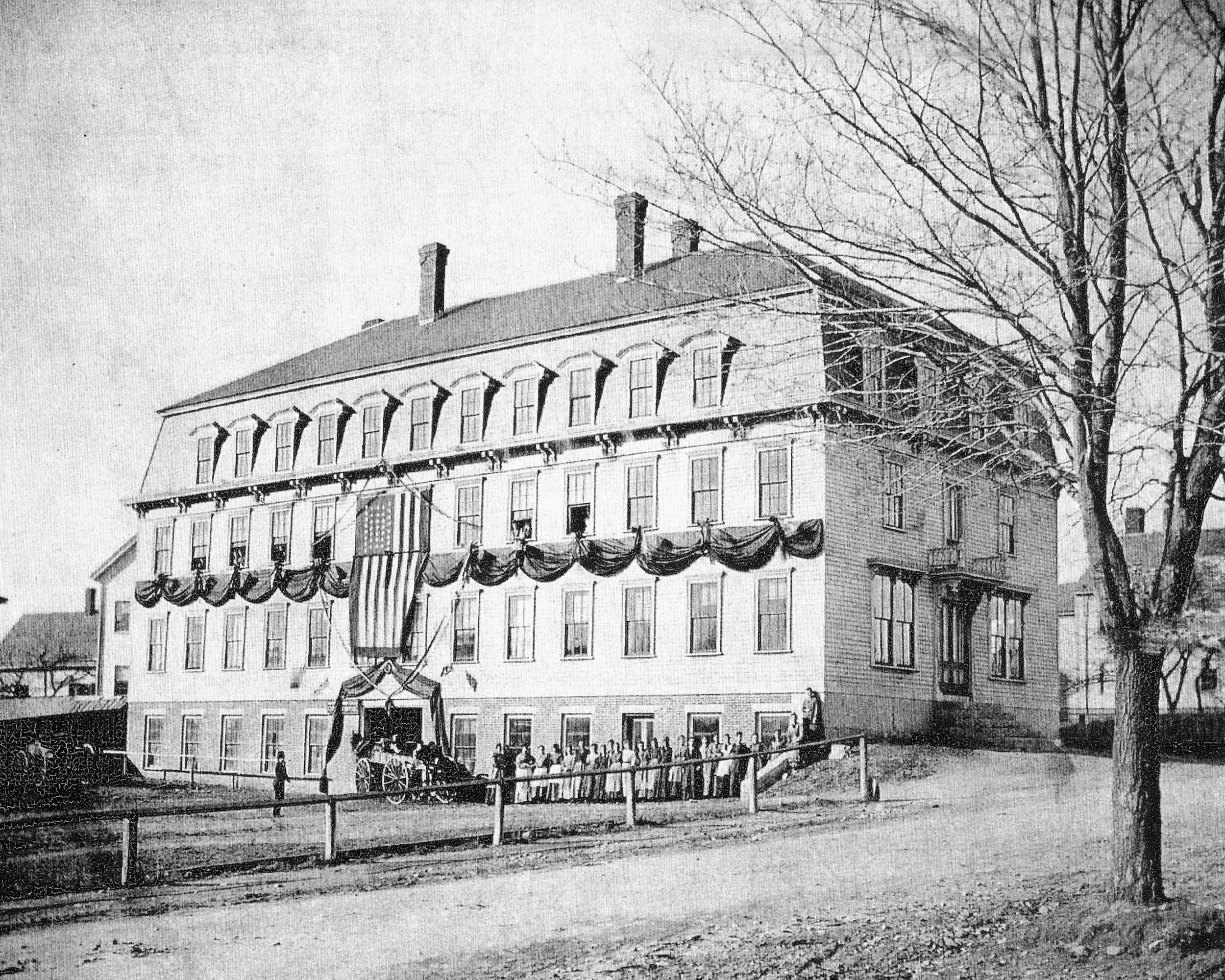
Henry Wilson’s “ten-footer” shoe workshop, on the National Register of Historic Places.
The “Ten-Footer” Workshop of Henry Wilson, the “Natick Cobbler”
Henry Wilson’s “ten-footer,” a shoemaker’s workshop (Courtesy of Kelli Connelly)
The tiny red wooden workshop at the corner of Mill Street and West Central Street is a “ten-footer” and it’s part of Natick’s history. It was used before the Civil War by Henry Wilson (1812-1875), a Natick shoemaker who served as Vice President of the United States from 1873 to 1875. He was born in Farmington, New Hampshire, into a financially troubled family. His name at birth was Jeremiah Jones Colbath. When Jeremiah was 10 years old, his father indentured him to a nearby farmer until age 21.
In 1833 he was released from his apprenticeship, and Jeremiah changed his name to Henry Wilson, inspired either by a biography of the Philadelphia school teacher Henry Wilson or by a portrait of the Rev. Henry Wilson in a volume on English clergymen. He then left Farmington and it is said that he walked 100 miles from Farmington to Boston, where he settled in the town of Natick. He became an apprentice to a master Natick shoemaker, and after just a few weeks of training Wilson ventured out on his own.
Wilson’s workshop, now on the National Register of Historic Places, is an authentic example of shoemaker shops once found in towns across Massachusetts when the state was becoming the nation’s largest shoe producer.
Cordwainer’s tools in the Wilson workshop (Courtesy of Kelli Connelly)
Interior of the Henry Wilson “ten-footer” workshop (Courtesy of Kelli Connelly)
When Henry Wilson arrived in Natick, shoemaking was a cottage industry, with much work in small workshops: “ten-footers,” roughly 10 feet square. After the mid-19th century, production was done in factories. In 1837, the railroad arrived in Natick, and the town’s shoemaking industry boomed. In 1838, at age 26, Henry Wilson employed 18 workers and produced 18,000 pairs of shoes. In 1847, his company manufactured 122,000 pairs of shoes and employed 109 workers.
Wilson’s specialty was a simple, inexpensive leather shoe called a “brogan.” Strictly speaking, Wilson was a “cordwainer,” a highly trained artisan who could make shoes using new leather, and not a “cobbler” who could only repair shoes. Most of his customers were in the American South, where many enslaved people on plantations wore them.
Wilson’s customers were mainly Southern slaveholders, but he was among America’s most vocal abolitionists. One of his friends told a story that revealed an instance in which Wilson’s disdain for slavery outweighed his financial interests. One of Wilson’s Southern customers was $700-$800 in arrears, equivalent to owing $13,600-$15,500 today. The customer sent a record of his assets to reassure Wilson that payment was forthcoming. When Wilson realized that his customer intended to settle the debt by selling enslaved people, he refused the payment.
In the 1850s, his interests shifted to the military and politics, particularly the nation’s growing antislavery movement. He joined the Natick militia and rose to brigadier general, proudly claiming the title of "General Wilson" throughout his political career. He represented Massachusetts in the U. S. Senate from 1855 to 1873. As a politician, Wilson loudly opposed the Democratic Party and its support of expanding slavery into the western territories. In December 1865, Wilson introduced the first civil rights initiative of the postwar Congress. His bill aimed at outlawing the Black Codes and other forms of racial discrimination in the former Confederacy but was deemed too extreme by the non-radical Republicans. Wilson also proposed that the Constitution be amended to prohibit any effort to limit the right to vote by race. A political adversary was the first to refer unkindly to Wilson as the “Natick Cobbler.” However, Wilson later turned the political slur into a political asset. In the 1872 presidential race, General Ulysses S. Grant and Henry Wilson campaigned under the Workingman’s Banner as the “Galena Tanner” and the “Natick Shoemaker.”
Wilson served as Grant’s vice president from 1873 until 1875. In 1885, a marble bust of Wilson by the sculptor Daniel Chester French was placed in the room of the Capitol where the vice president died. The Senate also installed a bronze plaque with an inscription written by his old friend and colleague, George F. Hoar:
In this room
HENRY WILSON
Vice President of the United States
and a Senator for Eighteen Years,
Died November 22, 1875
See Henry Wilson’s wallet, click here
Subscribe to illuminating and well-researched podcasts about Henry Wilson HERE
Selected sources and additional reading:
Natick Historical Society collections
United States Senate, https://www.senate.gov/about/officers-staff/vice-president/VP_Henry_Wilson.htm.


